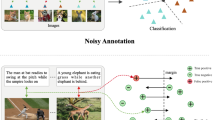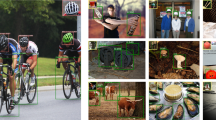Abstract
Learning effective feature spaces for KNN (K-Nearest Neighbor) classifiers is critical for their performance. Existing KNN loss functions designed to optimize CNNs in \(\mathbb {R}^n\) feature spaces for specific KNN classifiers greatly boost the performance. However, these loss functions need to compute the pairwise distances within each batch, which requires large computational resource, GPU and memory. This paper aims to exploit lightweight KNN loss functions in order to reduce the computational cost while achieving comparable to or even better performance than existing KNN loss functions. To this end, an anchor loss function is proposed that assigns each category an anchor vector in KNN feature spaces and introduces the distances between training samples and anchor vectors in the NCA (Neighborhood Component Analysis) function. The proposed anchor loss function largely reduces the required computation by existing KNN loss functions. In addition, instead of optimizing CNNs in \(\mathbb {R}^n\) feature spaces, this paper proposed to optimize them in hypersphere feature spaces for faster convergence and better performance. The proposed anchor loss optimized in the hypersphere feature space is called HAL (Hypersphere Anchor Loss). Experiments on various image classification benchmarks show that HAL reduces the computational cost and achieves better performance: on CIFAR-10 and Fashion-MNIST datasets, compared with existing KNN loss functions, HAL improves the accuracy by over \(1\%\), and the computational cost decreases to less than \(10\%\).




Similar content being viewed by others
Data availability and access
My manuscript has no associated data.
Notes
The number 10 in the amount of distances is related to the number of classes in the MNIST dataset.
The feature space used for KNN classifiers is also called KNN space in this paper.
Training accuracy predicted the category of a sample within a training batch by finding its closest 10 neighbors in the batch and then defining the label which happened most frequently among the neighbors as its predicted category.
Test accuracy means the common accuracy which predicts the category of a test sample by finding its neighbors in the training dataset. Test accuracy and accuracy are interchangeable in this paper.
References
Cover T, Hart P (1967) Nearest neighbor pattern classification. IEEE Trans Inf Theory 13(1):21–27
Zhou X, Ren Z , Zhou S,Yu T, Jiang Z (2023) Unsupervised saliency detection via knn mechanism and object-biased prior. Neural Process Lett 1–15
Maria A, Sunder R, Antony AM (2023) Stress prediction using enhanced feature selection and knn model. In: 2023 Advanced computing and communication technologies for high performance applications (ACCTHPA), pp 1–5
Lestari W, Sumarlinda S (2022) Implementation of k-nearest neighbor (knn) and suport vector machine (svm) for clasification cardiovascular disease. Int J Multi Sci 2(10):30–36
Sani S, Wiratunga N, Massie S (2017) Learning deep features for knn-based human activity recognition. CEUR Workshop Proceedings
Uddin S, Haque I, Lu H, Moni MA, Gide E (2022) Comparative performance analysis of k-nearest neighbour (knn) algorithm and its different variants for disease prediction. Sci Rep 12(1):6256
Gallego A-J, Calvo-Zaragoza J, Valero-Mas JJ, Rico-Juan JR (2018) Clustering-based k-nearest neighbor classification for large-scale data with neural codes representation. Pattern Recognition 74:531–543
Ren W, Yu Y, Zhang J, Huang K (2014) Learning convolutional nonlinear features for k nearest neighbor image classification. In: 2014 22nd international conference on pattern recognition, IEEE pp 4358–4363
Le L, Xie Y, Raghavan VV (2018) Deep similarity-enhanced k nearest neighbors.In: 2018 IEEE international conference on big data (Big Data), IEEE pp 2643–2650
Ghosh S, Singh A, Jhanjhi N, Masud M, Aljahdali S, et al.(2022) Svm and knn based cnn architectures for plant classification. Computers, Materials & Continua 71(3)
Lanjewar MG, Parab JS, Shaikh AY (2023) Development of framework by combining cnn with knn to detect alzheimer’s disease using mri images. Multimedia Tools and Applications 82(8):12699–12717
Gallego A-J, Pertusa A, Calvo-Zaragoza J (2018) Improving convolutional neural networks’ accuracy in noisy environments using k-nearest neighbors. Appl Sci 8(11):2086
Zhang S, Li J, Li Y (2022) Reachable distance function for knn classification. IEEE Trans Knowl Data Eng
Goldberger J, Hinton GE, Roweis ST, Salakhutdinov RR (2005) Neighbourhood components analysis. In: Advances in neural information processing systems, pp 513–520
Gallego A-J, Calvo-Zaragoza J, Valero-Mas JJ, Rico-Juan JR (2018) Clustering-based k-nearest neighbor classification for large-scale data with neural codes representation. Pattern Recogn 74:531–543
Hassanat AB (2018) Furthest-pair-based binary search tree for speeding big data classification using k-nearest neighbors. Big Data 6(3):225–235
Kobayashi S, Matsugu S, Shiokawa H (2022) Indexing complex networks for fast attributed knn queries. Soc Netw Anal Min 12(1):82
Hassanat A (2018) Norm-based binary search trees for speeding up knn big data classification. Computers 7(4):54
Skryjomski P, Krawczyk B, Cano A (2019) Speeding up k-nearest neighbors classifier for large-scale multi-label learning on gpus. Neurocomputing 354:10–19
Barrientos RJ, Riquelme JA, Hernández-García R, Navarro CA, Soto-Silva W (2022) Fast knn query processing over a multi-node gpu environment. The J Supercomput 1–27
Guerraoui R, Kermarrec A-M, Ruas O, Ta ïani F, (2020) Smaller, faster & lighter knn graph constructions. Proceedings of The Web Conference 2020:1060–1070
Abu-Aisheh Z, Raveaux R, Ramel J-Y (2020) Efficient k-nearest neighbors search in graph space. Pattern Recogn Lett 134:77–86
Nielsen MA (2018) Neural networks and deep learning. Determination Press. http://neuralnetworksanddeeplearning.com/
Acknowledgements
This work was supported by National Natural Science Foundation of China (No.62071060) and the Beijing Key Laboratory of Work Safety and Intelligent Monitoring Foundation.
Author information
Authors and Affiliations
Contributions
Xiang Ye contributed to design of the paper, data analysis and interpretation, drafting and revision of the manuscript. Zihang He contributed to the revision of the manuscript. Heng Wang contributed to the revision of the manuscript. Yong Li contributed to data analysis and interpretation, drafting and revision of the manuscript.
Corresponding author
Ethics declarations
Ethical and informed consent for data used
The data used in this paper are all publicly available database. The use of datasets was in compliance with the terms and conditions outlined by the datasets.
Conflicts of interest
The authors declare that they have no conflict of interest.
Additional information
Publisher's Note
Springer Nature remains neutral with regard to jurisdictional claims in published maps and institutional affiliations.
Rights and permissions
Springer Nature or its licensor (e.g. a society or other partner) holds exclusive rights to this article under a publishing agreement with the author(s) or other rightsholder(s); author self-archiving of the accepted manuscript version of this article is solely governed by the terms of such publishing agreement and applicable law.
About this article
Cite this article
Ye, X., He, Z., Wang, H. et al. Hypersphere anchor loss for K-Nearest neighbors. Appl Intell 53, 30319–30328 (2023). https://doi.org/10.1007/s10489-023-05148-5
Accepted:
Published:
Issue Date:
DOI: https://doi.org/10.1007/s10489-023-05148-5




